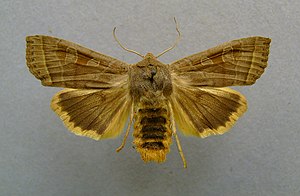Great winter owl
| Great winter owl | ||||||||||||
|---|---|---|---|---|---|---|---|---|---|---|---|---|

Great winter owl ( Orbona fragariae ) |
||||||||||||
| Systematics | ||||||||||||
|
||||||||||||
| Scientific name | ||||||||||||
| Orbona fragariae | ||||||||||||
| ( Vieweg , 1790) |
The great winter owl ( Orbona fragariae ), also called strawberry owl, is a butterfly ( moth ) from the owl butterfly family (Noctuidae).
features
butterfly
The wingspan of the strikingly large moth is 54 to 62 millimeters. The basic color of the forewings varies from red-brown to gray-brown. Kidney and ring flaws are always lighter. The yellowish wavy line, which is darkened towards the inside, runs relatively straight. A few dark spots can be seen near the outer edge. The hind wings are black-brown in color, show a dark moon spot and a yellow front edge and distinctive yellow fringes. The abdomen is also colored yellow and provided with wide black cross bars.
Caterpillar
Younger caterpillars are predominantly greenish in color. A brown basic color predominates in the adult animals. The lower area is a little lighter and shows white stigmas . The black-brown pronotum is very striking.
Similar species
The butterflies are unmistakable due to their extraordinary size and their striking design.
distribution and habitat
The distribution of the species extends from central Europe further east over Siberia to the Pacific Ocean . The animals are mainly to be found on the edges of forests, on forest meadows and on stony slopes and heaps. They are absent at higher altitudes in the mountains.
Way of life
The moths are both diurnal and nocturnal and live from the end of August after hibernation until May of the following year. They then suckle on blooming pussy willows or ingest sap from injured trees. Due to their large need for food after hibernation, they also like to visit bait in spring . They only appear occasionally at night in artificial light sources . Despite the name of the species and various references in the literature, in which the strawberry ( Fragaria ) is specified as the forage plant of the caterpillars, these should not be found on strawberry plants outdoors. Rather, they feed on other plants, for example plantain ( Plantago ), dandelion ( Taraxacum ), bedstraw ( Galium ), clematis ( Clematis ), vetches ( Vicia ) or willow species ( Salix ) and blackthorn ( Prunus spinosa ) . In the literature, the caterpillar is sometimes referred to as a murder caterpillar or as cannibalistic, which, however, is emphatically denied. The caterpillar season covers the months May to August. After pupation in a burrow, the moths appear after a very short pupal rest.
Danger
The great winter owl is considered to be extinct in most of its earlier range in Germany. It is classified in category 1 (critically endangered) on the Red List of Threatened Species . However, some recent findings from Bavaria suggest that the species is again in a phase of spreading. In Austria it is widespread in the Alpine region. It is to be classified as a bio-indicator for climate-favored deciduous forest communities.
swell
Individual evidence
- ↑ a b c Lázló Ronkay, José Luis Yela & Márton Hreblay: Hadeninae II . In: Michael Fibiger, Martin Honey (Ed.): Noctuidae Europaeae . tape 5 . Entomological Press, Sorø 2001, ISBN 87-89430-06-9 (English).
- ↑ Walter Forster , Theodor A. Wohlfahrt : The butterflies of Central Europe. Volume 4: Owls. (Noctuidae). Franckh'sche Verlagshandlung, Stuttgart 1971, ISBN 3-440-03752-5 .
- ^ Günter Ebert (Ed.): The butterflies of Baden-Württemberg . 1st edition. tape 6 . Moth IV. Noctuidae 2nd part. Ulmer, Stuttgart (Hohenheim) 1997, ISBN 3-8001-3482-9 .
- ↑ A. Keller: Entomological Notes In: Stettiner Entomologische Zeitschrift, No. 33, 1862
- ↑ W. Steudel: About the caterpillar of Orrhodia Fragariae Esp. (Serotina O.) In: Annual booklet of the Association for Patriotic Natural History in Württemberg, No. 40, 1884
- ↑ Federal Agency for Nature Conservation (Ed.): Red List of Endangered Animals in Germany . Landwirtschaftsverlag, Münster 1998, ISBN 3-89624-110-9 .
- ↑ Gerfried Deschka, Josef Wimmer, The Butterfly Fauna of the Cross Wall, Contribution. Naturk. Upper Austria, 2000
literature
- Lázló Ronkay, José Luis Yela & Márton Hreblay: Hadeninae II . In: Michael Fibiger, Martin Honey (Ed.): Noctuidae Europaeae . tape 5 . Entomological Press, Sorø 2001, ISBN 87-89430-06-9 (English).
- Günter Ebert (Ed.): The butterflies of Baden-Württemberg . 1st edition. tape 6 . Moth IV. Noctuidae 2nd part. Ulmer, Stuttgart (Hohenheim) 1997, ISBN 3-8001-3482-9 .
Web links
- Lepiforum eV photos
- www.schmetterlinge-deutschlands.de Endangerment
- Orbona fragariae at Fauna Europaea